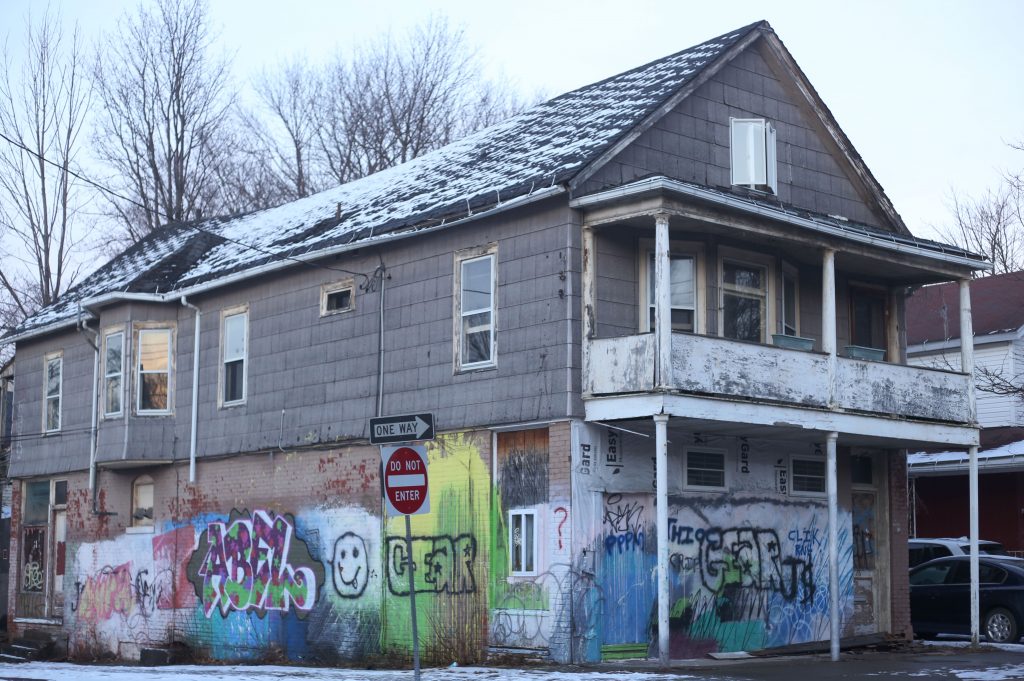
After nearly a decade of litigation halting progress on repairing and maintaining 26 Seminary Ave., the residence has become dilapidated and covered in graffiti, with no solution in sight.
Although residents on Binghamton’s West Side have become accustomed to viewing this home, which sits on the corner of Seminary Avenue and Chapin Street, Sarah Prechtl, a first-year graduate student studying electrical and computer engineering, said the building’s unsightly appearance has impacted the neighborhood itself.
“I don’t know much about the house other than it looks like a trap house, but that just means cheaper rent for me,” Prechtl said. “I personally have never suffered at the expense of this house, so it doesn’t bother me too much.”
The legal battles that created the building’s neglected state originally started as an attempt to renovate it. According to court records, the property’s owner, Isaac Levin, alleged in 2010 that the Binghamton City Council had violated his rights by preventing him from altering his house due to zoning regulations. Since then, the case has been at a standstill in regard to what changes the owner, as well as the city, can legally make to the building.
Ylli Dema, a first-year graduate student studying biomedical engineering, said most of the neighborhood is unaware of the legal complications regarding the building. However, he often wonders what the building might become in the future.
“I personally have always been confused as to why it hasn’t been flipped into a good student house because it’s a pretty good location for it,” Dema said. “I think someone should buy it and flip it.”
Although there have been several changes in elected members, the City Council is still concerned about the building’s effect on the neighborhood’s appearance. Deputy Mayor Jared Kraham said this particular property has been in the court system for years, preventing any activity or development surrounding it.
“While it was under litigation there was little that could be done from a redevelopment, a strictly ownership or even a code-enforcement standpoint,” Kraham said. “It’s been difficult because without getting out of litigation, it’s hard for me or anyone else in the city to discuss next steps.”
In March 2009, under the approval of former Binghamton Mayor Matthew Ryan, the city council passed Ordinance 410, which states, in Section 36, that official site plans must be approved by the City Planning Commission for any existing building to be permanently altered.
Certain aspects of Ordinance 410 are important to Levin’s case, particularly Section 5, which specifies the difference between a one-unit and a two-unit dwelling, such as a duplex. According to court records, Levin’s original application to the Department of Planning, Housing and Community Development and the Zoning Board of Appeals was for a one-unit dwelling, but the alteration plans that he submitted would have changed the building into a two-unit dwelling.
“Some code-related violations have been issued over the years, and because there was active litigation, obviously our Code Enforcement Department was legal about what could and couldn’t be done,” Kraham said. “So that’s the only city role that we’ve had.”
According to court records, after Levin received the Zoning Board’s initial denial to renovate his house, he relabeled the blueprint’s rooms in an attempt to get approval. In response, the board stated that a permit is necessary to convert a single-family residence into a two-family residence, and regardless of how Levin labeled the plans, it was clear that the house would become a two-unit dwelling.
“These issues kept them contacting the property owner in [regard] to violations,” Kraham said. “Because it was under litigation, I don’t have a comment about redevelopment, but it goes without saying that it’s a notorious eyesore on the West Side of Binghamton.”
According to Kraham, there are similar cases of blighted houses throughout the the city, and until litigation is resolved for 26 Seminary Ave., the house will remain in its current state.


